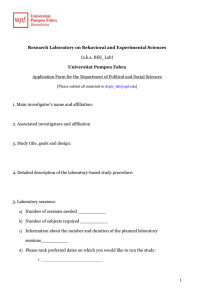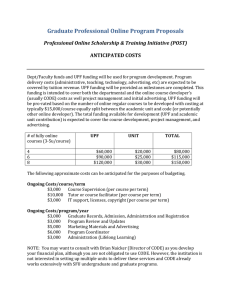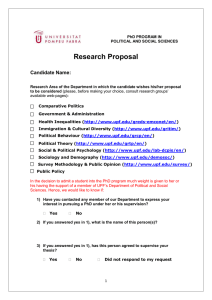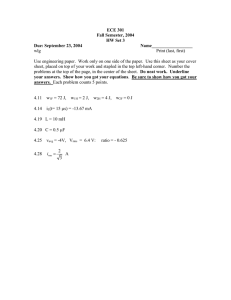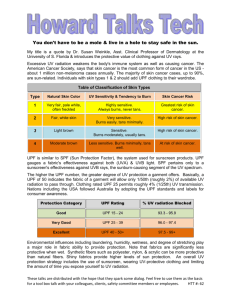Teaching Plan
advertisement
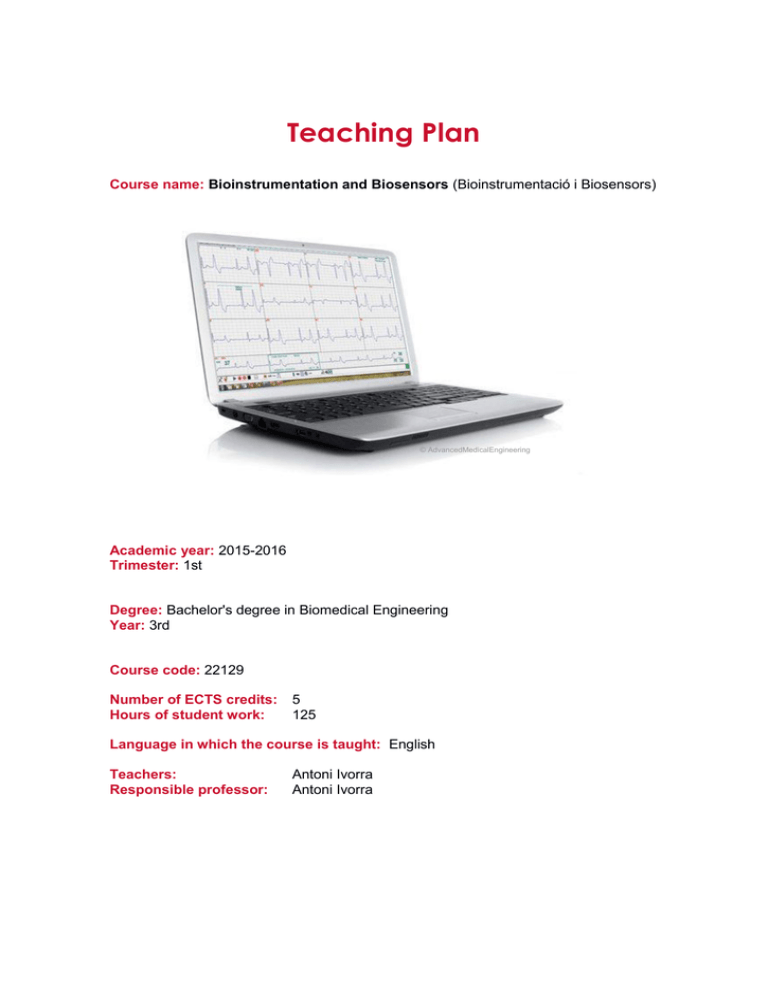
Teaching Plan Course name: Bioinstrumentation and Biosensors (Bioinstrumentació i Biosensors) © AdvancedMedicalEngineering Academic year: 2015-2016 Trimester: 1st Degree: Bachelor's degree in Biomedical Engineering Year: 3rd Course code: 22129 Number of ECTS credits: Hours of student work: 5 125 Language in which the course is taught: English Teachers: Responsible professor: Antoni Ivorra Antoni Ivorra 1. Course descriptors Course name: Bioinstrumentation and Biosensors (Bioinstrumentació i Biosensors) Course acronym: BIS Academic year: 2015-2016 Trimester: 1st Degrees: Bachelor's degree in Biomedical Engineering Year: 3rd Course code: 22129 Number of ECTS credits: Hours of student work: 5 125 Language(s) in which the course is taught: English (all written materials). Exceptionally, under request and if students unanimously agree, lectures will be taught in Catalan or Spanish. Teachers: Antoni Ivorra antoni.ivorra@upf.edu Lab assistant: Genís Caminal genis.caminal@upf.edu Responsible professor: Antoni Ivorra 2. Course presentation This course mostly deals with theoretical and practical aspects regarding the acquisition of numerical data and signals from human body by means of electrodes and electronic sensors. The course aims three main teaching objectives: 1- to overview the fundamental features of modern medical measurement systems and the mathematical, physical and electronic foundations of those systems, 2- to introduce the principles of design for electronic circuits capable of safely interfacing electronic sensors and electrodes to digital systems and 3- to put in practice the above knowledge – and to get some lab and hardware prototyping skills – by implementing and testing a simple medical measurement system. Short syllabus: Introduction to measurement systems, circuit theory fundamentals, electrical safety fundamentals, overview of biomedical electrodes and electrochemical sensors, overview of modern electronic technology and physical sensors, signal conditioning circuits based on operational amplifiers and instrumentation amplifiers, analog-to-digital converters, biopotential recording systems. Prerequisites: 1- very basic knowledge of circuit theory (i.e. Ohm’s law, Kirchhoff’s circuit laws, RC circuits charge and discharge equations, …), 2- undergrad level general physics (e.g. physics first year course in any engineering discipline), 3- signal theory basics (i.e. Fourier transform and sampling theory) and 4- Matlab programming basics. In terms of courses from the Bachelor's degree in Biomedical Engineering at the UPF: “Bioelectromagnetisme”, “Teoria de Senyals i Sistemes” and “Tècniques Computacionals en Biomedicina”. 3. Competences the course aims to teach or to train Transversal competences Instrumental INS1. Ability for analysis and synthesis INS2. Organization and planning ability INS3. Ability for applying knowledge in practice INS7. Oral and written communication in English in academic or professional environments. Interpersonal INT1. Teamwork Systemic SIS1. Ability for applying flexibly and creatively the acquired knowledge to new scenarios. SIS4. Concern for quality Specific competences Professional specific competences B1. Ability for solving mathematical problems which may appear in engineering. Aptitude for applying knowledge on: linear algebra; geometry; differential geometry; differential and integral calculus; differential equations; numerical methods; numerical algorithms; and statistics. B2. Ability to use and program computers. Ability to use diverse operating systems, data bases and computer programs intended for engineering. B6. Knowledge on linear systems, circuit theory, electronic circuits, electronic and photonic devices, materials technology. P1. Ability for engineering projects preparation and development P5. Knowledge for taking measurements, performing calculations, technical reports, task planning and other analogous tasks. Fundamental learning specific competences IB1. Development and implementation of techniques for computational analysis of multimodal signals and images for diagnosis and monitoring. IB2. Design and development of technologies for acquisition, processing, modeling, visualization and interpretation of biological signals and physiological and clinical variables that can be used for medical prevention, diagnosis, treatment and rehabilitation. IB3. To understand the main physiopathological mechanisms and to computationally model the diverse organ systems of the human body, with emphasis on the cardiovascular system, the nervous system and the locomotor system. IB7. To understand and to distinguish diverse techniques and systems for biomedical signals and images which are capable of providing both structural and functional information from multiple biological and physiological processes. Other competences O1. Ability for implementing simple electronic circuit prototypes based on discrete components. O2. Ability for performing circuit analysis using a SPICE simulator. 4. Contents Contents module identifier Contents module title and main topics Introduction to measurement systems Module 1 (M1) - Sensors and transducers (definitions and main concepts) - General architecture of modern data acquisition systems - Measurement systems characteristics (Accuracy, Precision, Repeatibility, Reproducibility, Resolution, Range, Span, Linearity, Transfer function, Sensitivity, Hysteresis, Drift, Selectivity) - Calibration and systematic and random errors - Reporting uncertainty Circuit theory fundamentals and electrical safety Module 2 (M2) - Physical meaning of voltage and current. Ideal sources. Thermopiles. - Ohm’s law - Electrical power - Kirchhoff’s circuit laws - Voltage dividers - Potentiometers - Superposition of independent sources - Equivalent circuits - Diodes - Transformers - Capacitance - Time transients in RC circuits - Impedance - Transfer function (frequency analysis) - Noise - Conductively, capacitively and inductively coupled interferences - Simple passive filters - Electrical Safety: - Electrical shock hazards - Macroshock and Microshock - Prevention of electrical hazards - Isolation Signal conditioning circuits and analog-to-digital conversion Module 3 (M3) - Ideal operation amplifier (OA) - Inverting and non-inverting OA configurations - Common mode voltage and differential voltage - Output voltage saturation - Differential amplifier configuration - Instrumentation amplifier - Wheatstone bridge - Strain gauges - Pressure sensors - Active filters - Biopotential amplifiers - Single supply OAs - Limitations of real OAs (offset voltage, bias currents, bandwidth, slew rate) - Multiplexors and relays - Sample-and-hold - ADCs architectures - Digital sensors Electrodes Module 4 (M4) - Electrolytes - Electrical models for electrodes - Ion Selective Electrodes - Polarizable and non-polarizable electrodes - Recording electrodes, stimulation electrodes Laboratory Module 7 (M5) (Laboratory) - SPICE simulations - Arduino microcontroller platform and its interface to MATLAB - Acquisition and representation of dc and ac signals with Arduino + Matlab - Fabrication of a flow transducer - Design and implementation of signal conditioning electronics for differential pressure sensing - Design and implementation of MATLAB code for spirometry - Calibration, test and characterization of the implemented spirometry system 5. Methodology This course follows a conventional academic structure in which lectures and problem solving seminars are combined with short tests – for feedback purposes – and a final written exam. In addition, five supervised laboratory sessions will be conducted. Lectures and problem solving seminars. Contents modules M1 to M4 will be taught in a conventional manner. That is, lectures on theoretical and practical aspects, together with examples of solutions to problems, will be given by the professor. In seminars exclusively devoted to problem solving, the students will have the opportunity to interactively participate in the class. Lab sessions. The five supervised lab sessions, of two hours each, are aimed towards the development and characterization of a spirometry system (sensor + electronics + software). The first two lab sessions – in which the Arduino platform and its interface with Matlab are introduced as a data acquisition system of unspecified application – will be fully guided. That is, the students will have to follow a lab guide in which all the consecutive steps for performing the circuits, the measurements and the software will be detailed. These two guided lab sessions will require that the students study in advance some specific materials contained or indicated in the lab guide. Such previous study will not be tested directly at the beginning of the sessions but it will be assessed in a short multiple-choice test at the end of the second lab session (AL1). No report will be required for any of these two guided lab sessions The other three supervised lab sessions will be truly devoted to the development of the spirometry system. The first one (and a half) of these sessions – in which the sensing system and the electronics will be simulated and built – will be guided but the other two will only be loosely supervised. It is expected that each team comes with original implementations concerning software and system characterization. Performance of the implemented system will have to be demonstrated at the end of the fifth session. Extra unsupervised lab sessions will be allocated so that students will be able to freely work on their developments with all lab resources at their disposal. A significant portion (50%) of the grade for this activity (AL3) will be determined by a secret ballot in which the students will rank the systems developed by their peers. The students will have to prepare a very short report (2 pages) – a brochure – on the main features of the developed system for facilitating assessment by their colleagues. At the last lab session, in addition to the assessment of the spirometry system, an execution test (AL2) will be performed to individually asses the circuit simulation capabilities of the students. It will consist in solving a number of circuit problems by performing LTSpice simulations. Hours in classroom (or supervised lab) Contents module Hours outside the classroom (and unsupervised lab) LECTURE (medium group) SEMINAR (medium group) LAB (small group) M1 2 1 – 7 M2 6 7 – 22 M3 6 7 – 22 M4 2 1 – 6 M5 Total – 2 10 24 16 18 10 81 125 6. Assessment Some common remarks: In case a student cannot attend a session in which a test is performed (AC1, AC2, AL1 and AL2), his or her grade for that test will be 0. Under no circumstances tests will be repeated for individual students. As a general rule, grades for lab activity AL3 will be the same for both lab team members. In case a student cannot attend the lab session in which this activity is assessed (AL3), his or her labmate will carry out the activity by himself or herself and, under the agreement of the present labmate, the non-attending student will get the same grade as assessed student. Punctuality will be strictly enforced. Particularly in lab sessions: nobody will be admitted in lab 20 minutes after the scheduled start time and grades will be penalized since 5 minutes after the scheduled start time. Grade revision dates for tests will be indicated in the Aula Global. Very important: copies or plagiarism will not be tolerated at all! Assessed Competences Assessment activity (and typology) Assessment methodology and criteria Minimum grade to pass the course Recoverable (in July) Weight on final grade INS3, B1, B6, IB1, IB2 AL1. Lab introduction feedback test (Written Test) Short multiple-choice test performed at the end of the second lab session. 0 No 5% INS1, INS3, INS7, SIS1, B1, B2, B6, P5, IB1, IB2, O2 AL2. LTSpice lab test (Written and Execution tests) Execution test to individually asses circuit simulation capabilities. It will consist in solving a number of circuit problems by performing LTSpice simulations. 0 No 10% AL3. Spirometry project demonstration (Execution test) The professor will check the performance of the implemented system. If a set of basic performance features is met, 5 points (out of 10) will be granted. The remainder grade points (5) will be determined by a secret ballot in which the students will rank the systems developed by their peers (grade proportional to rank). For facilitating assessment by their peers, each team will have to prepare in advance a brochure (2 pages) on the main features of the developed system. The students will be asked to rank the systems in terms of capability to perform the requested measurements and the accuracy of those measurements (35%), appearance and quality of the software interface (35%) and originality and added difficulty of the implemented solutions (30%). 0 No 7.5% + 7.5% AC1. M1-M2 feedback test (Written Product) Multiple-choice test plus one to three problems. 0 No 5% AC2. M3 feedback test (Written Product) Multiple-choice test plus one to three problems. 0 No 10% AF. Final exam (Written Test) Modules 1 to 4 will be assessed by multiple choice questions plus three to ten comprehensive problems to be solved. 5 over 10 Yes 55% INS1, INS2, INS3, INT1, SIS1, SIS4, B1, B2, B6, P1, P5, IB1, IB2, O1, O2 INS1, INS3, INS7, B1, B6, P5, IB1, IB2, IB7 INS1, INS3, INS7, B1, B6, P5, IB1, IB2, IB3, IB7 INS1, INS3, INS7, B1, B6, P5, IB1, IB2, IB3, IB7 7. Schedule week Monday or Tuesday plenary sessions Plenary lesson or seminar (T1 & P101) Wednesday - Friday plenary sessions Plenary lesson or seminar (T1 & P101) Laboratory sessions (Friday) (S101 and S102) 1 (no class) (Wednesday 12:30 – 14:30) Course presentation (M0) and Lecture M1 (no lab) (Tuesday 10:30 – 12:30) Lecture M1 Seminar M1 (Friday 10:30 – 12:30) Lecture M2.A (no lab) Oct 05 – Oct 09 (Monday 10:30 – 12:30) Lecture M2.B (no class) (no lab) 4 (Friday 8:30 – 10:30) Seminar M2 S101. Lab 1 (10:30 – 12:30) (no class) Sept 21 – Sept 25 2 Sept 28 – Oct 02 3 Oct 12 – Oct 16 5 Oct 19 – Oct 23 6 Oct 26 – Oct 30 7 Nov 02 – Nov 06 (no class) (Friday 10:30 – 12:30) Lecture M2.C (Monday 10:30 – 12:30) Seminar M2 (Thursday 10:30 – 12:30) AC1. M1-M2 test + Seminar M1-M2 (Monday 8:30 – 10:30) Lecture M3.A (no class) Nov 09 – Nov 13 (Monday 10:30 – 12:30) Lecture M3.B 9 (no class) 8 Nov 16 – Nov 20 10 Nov 23 – Nov 27 (Monday 10:30 – 12:30) AC2. M3 feedback test (Tuesday 14:30 – 16:30) Lecture M3.C S102. Lab 1 (12:30 – 14:30) (no lab) S101. Lab 2 (10:30 – 12:30) S102. Lab 2 (12:30 – 14:30) S101. Lab 3 (10:30 – 12:30) S102. Lab 3 (12:30 – 14:30) (Wednesday 14:30 – 16:30) Seminar M3 (Thursday 14:30 – 16:30) Seminar M5 (LTSpice) S101. Lab 4 (10:30 – 12:30) S102. Lab 4 (12:30 – 14:30) (no class) (no lab) (Thursday 10:30 – 12:30) Lecture M4 (no lab) S101. Lab 5 (10:30 – 12:30) + 11 Nov 30 – Dec 04 (Monday 10:30 – 12:30) Seminar M3 (Thursday 10:30 – 12:30) Seminar M1-M4 (15:30 – 17:30) S102. Lab 5 (12:30 – 14:30) + (15:30 – 17:30) 12-14 Dec 07 – Dec 22 AF. Final exam (date to be determined) Notes: Extra unsupervised lab sessions will be allocated between Lab 3 and Lab 5. In these unsupervised lab sessions – in which no professor will be present – the electronics lab 54.028 will be open for the students and the lab assistant, Genis Caminal, will be there for providing the materials and tools and to keep an a eye on materials and instruments. At the end of Lab 2 and Lab 5 sessions, assessment activities AL1 and AL2+AL3 respectively, will be carried out. Assessment activities list Activity AC1. Feedback test on M1-M2 AL1. Lab intro. test AC2. Feedback test on M3 AL2. LTSpice lab test AL3. Spirometry project AF4. Final exam Relevant dates Test on 29/10/2015 Grades publication on 5/11/2015 Test on 30/10/2015 Grades publication on 07/11/2015 Test on 23/11/2015 Grades publication on 4/12/2015 Test on 04/12/2015 Grades publication on 11/12/2015 Brochure electronically sent to professor on 01/12/2015 Demonstration and ballot on 04/12/2015 Grades publication on 09/12/2015 (to be announced) 8. Bibliography and didactic resources Recommended books for the course: 1. “Foundations of Analog and Digital Electronic Circuits”, Anant Agarwal and Jeffrey H. Lang, publisher: Morgan Kaufmann, 2005. Covers most M2 and M3 partially; extensive collection of problems. [Five copies at the UPF library]. 2. “Principios de Electrónica” (Electronic Principles), Albert Paul Malvino, publisher: McGraw-Hill, 2007. Covers most M2 and M3 partially; extensive collection of problems. [Three copies at the UPF library]. 3. “Medical Instrumentation Application and Design”, 4th edition, John G. Webster (editor), publisher: Wiley, 2009. Covers M1 partially, M2 (safety), M3 (biopotential amplifiers) and M4 partially; contains some problems. [Three copies at the UPF library]. 4. “Introduction to Biomedical Equipment Technology”, 4th edition, Joseph J. Carr and John M. Brown, publisher: Prentice Hall, 2000. Covers M1 in detail, M3 and M4 partially; contains some problems. [Two copies at the UPF library]. 5. “Biomedical Device Technology: Principles and Design”, Anthony Y. K. Chan, publisher: Charles C Thomas Pub Ltd, 2008. Covers M1 partially, M2 (safety), M3 (biopotential amplifiers) and M4; contains a few solved exercises. [Available as electronic resource at the web site of the UPF library]. Support books (further reading): 1. “Introduction to Engineering Experimentation”, 3rd Edition, Anthony J. Wheeler and Ahmad R. Ganji, publisher: Prentice Hall, 2009. Advanced contents on M1; good collection of problems. [Two copies at the UPF library]. 2. “Medical Devices and Systems”, (volume 3 of “The Biomedical Engineering Handbook”), 3rd edition, Joseph D. Bronzino (editor), publisher: CRC/Taylor & Francis, 2006. Contents on M1, M2, M3 and M4. [Available as electronic resource at the UPF library web site]. 3. “Linear Circuit Design Handbook”, edited by Hank Zumbahlenas with the engineering staff of Analog Devices, publisher: Elsevier/Newnes Press, 2008. Advanced contents on OPAMP circuits (M3) [Available as electronic resource at the UPF library web site]. 4. “Bioimpedance and bioelectricity basics”, 2nd edition, Sverre J. Grimnes and Orjan G. Martinsen, Publisher: Academic Press, 2008. Advanced contents on M4. [Available as electronic resource at the UPF library web site]. 5. “The Art of Electronics”, 3rd edition, Paul Horowitz and Winfield Hill, publisher: Cambridge University Press, 2015. Excellent book for those of you interested in further self-learning on electronics after the course. [Three copies at the UPF library]. Note: all these books focus on different specific topics covered by the course. Unfortunately, each one of these books either does not cover some topics of the course or goes much deeper into the topics than what required in the BIS course, or both. That is, none of them should be considered singly as the reference book for the course (i.e. textbook).
